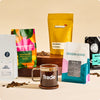Grab your wetsuits, we're taking a deep dive into some of our favorite café drinks. This time out, we’re going in on the small but mighty ristretto to satisfy the taste buds of any coffee lover.
Key facts
Definition: From Italian, meaning restricted or condensed. An espresso made with less hot water than normal.
Pronunciation: Ri-strét-to
What is ristretto?
A ristretto, simply put, is an espresso shot made with less hot water. In the world of espresso brewing methods, the ristretto shot is created by the act of stopping an espresso shot before the bittering components start to develop, resulting in a shot with a condensed sweetness, a full, intense flavor, and a lingering finish.
But what does “less” mean when you’re trying to make espresso at home, anyway? Achieving this doesn’t necessarily mean pulling a shot as normal and just stopping the shot, as that would result in sour, under-extracted flavors. It’s a popular misconception that this is what a ristretto is.
To understand what “less” means, it’s important to understand general Italian terms for espresso, how they describe length versus size. The Italian terms for espresso coffee are separated by length and size; normale, ristretto, lungo (length) versus single, double, and triple (size).
Length is attributed to the end volume of the shot, whereas the size is connected to the starting dosage, AKA the amount of ground coffee that is used to prepare the shot.
A ristretto will have 20 to 30 milliliters; a normal shot will have 40 to 60 milliliters in volume, whereas a lungo will have 60+ milliliters of coffee. In most US specialty shops, even if it’s a single or a triple shot, all espresso coffee is pulled as a double shot. A single espresso or ristretto shot is achieved by splitting a double shot in half.
When starting with a normale (normal) double shot, it’s typical to use about 14 to 18 grams of ground coffee, targeting a volume of 40 to 60 milliliters in about 25 seconds. A single shot is exactly half of this, but it’s typical that a double shot will be split to create a single coffee shot in the same amount of time.
With a ristretto, it’s typical to use about 20 grams of coffee for a double shot, targeting 20 to 30 milliliters in about 25 seconds.
Lungo coffee uses the same amount of coffee as a normal shot in the same amount of time, but the volume is much larger. This is due to a coarser espresso grind being used.
Want to know more about measuring coffee? Learn how many tablespoons of coffee per cup you need to strike the perfect balance for your daily brew.
History of the ristretto
While ristretto coffee is a very Italian way to describe coffee, it was adopted in the US by David Schomer at Espresso Vivace in Seattle. A double ristretto became the specialty standard here in the early '90s. According to David Schomer, “The beauty of caffe espresso is the ability to preserve the fragrance of the roast, and caramelized sugars, through the brewing process into a thick chiffon with a silky mouth-feel.”
He accomplished this with a ristretto shot that is no more than two ounces for a double shot and no more than an ounce for a single shot. The exact recipe he proposes involves 20 grams of coffee, pulled in 27 to 35 seconds, at 20 to 25 milliliters volume. Ristretto coffee has been written up by various other publications, but none describe it the way Schomer does.
How it’s made
A common misconception of a ristretto is to pull 20 to 25 milliliters of volume (up to 30 milliliters) with the same grind and dose as a normal shot. This results in quicker extraction and enhanced acidic flavors. By increasing the amount of coffee from 14 to 18 grams — as a normal extraction — to 20 grams, you’re actually increasing the concentration of the regular espresso and decreasing the extraction itself.
For instance, let’s say you pull a “normal'' double shot at 18 grams for 25 seconds and get 40 milliliters of liquid. Then let’s say you pull another regular shot that’s 20 grams of coffee for the same amount of time and get 25 milliliters of coffee. You’re extracting less from the second extraction, getting a more syrupy mouthfeel and concentration of flavors. The goal of the ristretto is to emphasize the sweetness and concentration of the flavors, leaving the drinker with a long, lingering mouthfeel after the last drop.
What does it taste like?
When experimenting with different coffee processing methods, I decided to make my own ristretto using 20 grams of coffee. I pulled a coffee shot that was about 30 milliliters in 25 seconds. The result was intense, sweet caramel and a bitter chocolate flavor on the finish.
In comparison to my regular espresso recipe of 18 grams in 25 to 30 seconds, I got more sweetness but also more fruit like acidity. The aftertaste was much more intense and I felt it lingering on my palate for several minutes, which is not something I’ve experienced so intensely outside of wine tasting.
Coffee recommendations
An intense caramelized sugar sweetness, green apple, stone fruit and a lingering, Onyx Rwanda Kanzu's silky body makes this a dynamic choice as an espresso, no matter how you pull it.
Deep, dark and roasty, Oren’s Italian Roast is a sweet cup that makes an excellent rendition of an Italian Roast with plenty of dark chocolate and caramel for days.
Rich, bittersweet caramel and deep dark chocolate undertones makes George Howell's Tarrazu a fantastic option for a classic cup.
Curious about which espresso coffee is best for you? Perhaps you’re willing to try an espresso tonic? Regardless, Trade is here to help you find the best brew to craft the perfect coffee taste.






